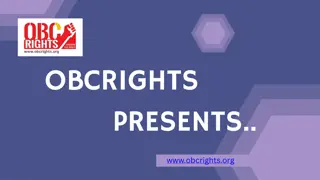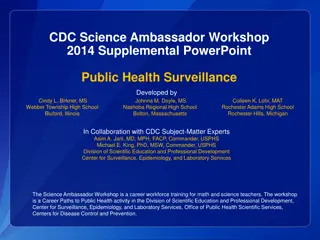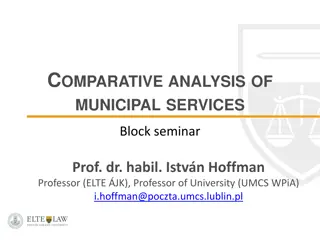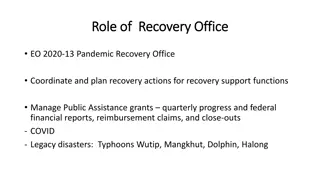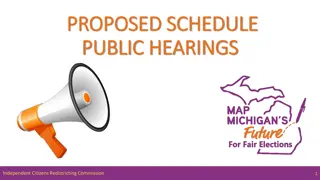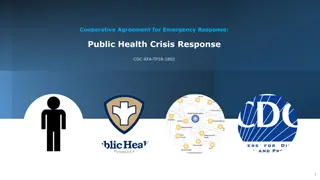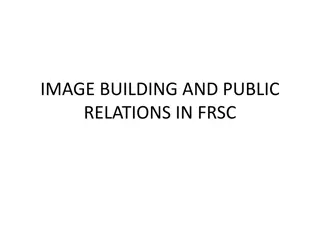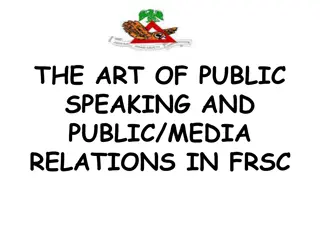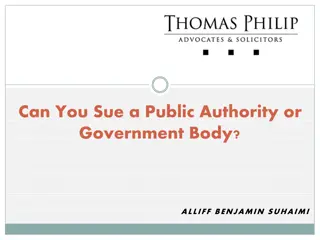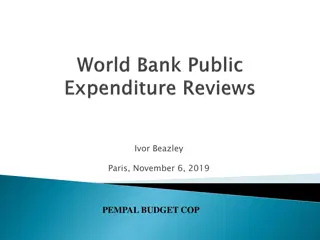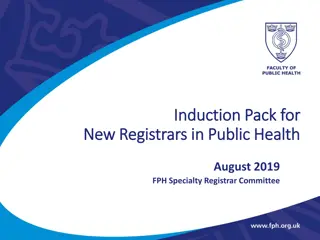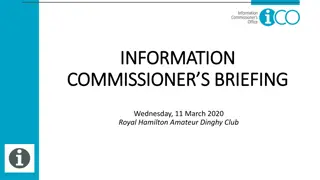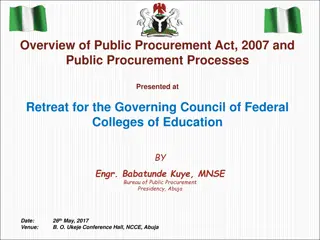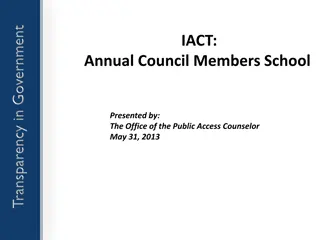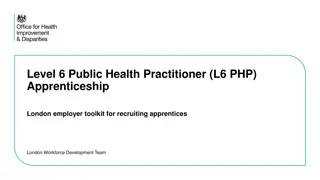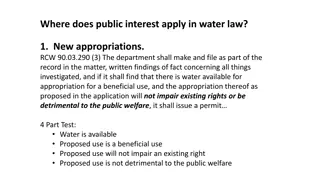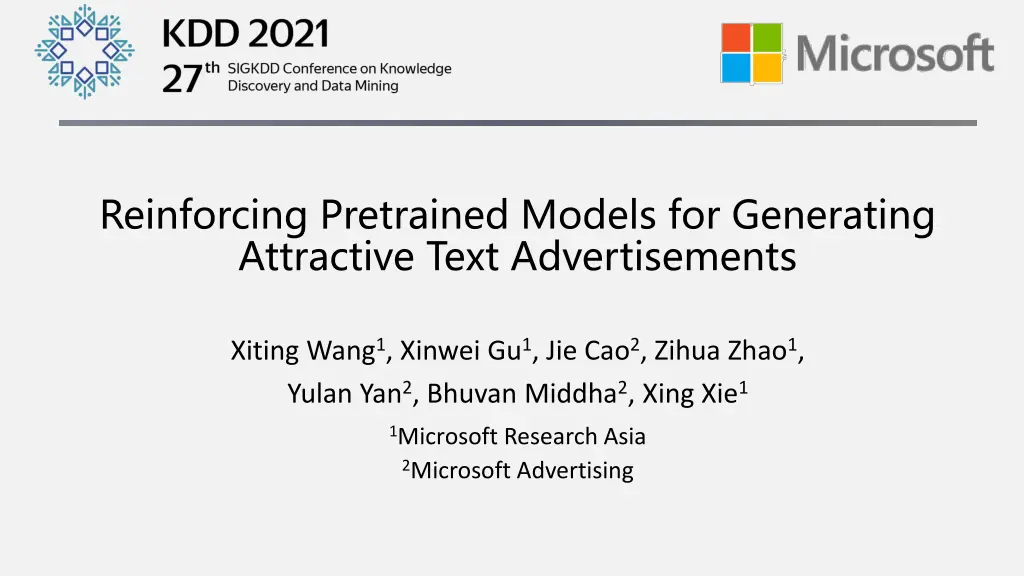
Generating Attractive Text Ads with Pretrained Models and Reinforcement Learning
Explore how to create appealing text advertisements that rival the quality of advertising mediums using pretrained models and reinforcement learning. The method involves a three-phase training schema, leveraging various data types, fine-tuning, unsupervised and supervised data, user feedback, and a Model-Based RL Framework. The approach significantly enhances revenue and click yield in advertising platforms like Microsoft Bing.
Download Presentation

Please find below an Image/Link to download the presentation.
The content on the website is provided AS IS for your information and personal use only. It may not be sold, licensed, or shared on other websites without obtaining consent from the author. If you encounter any issues during the download, it is possible that the publisher has removed the file from their server.
You are allowed to download the files provided on this website for personal or commercial use, subject to the condition that they are used lawfully. All files are the property of their respective owners.
The content on the website is provided AS IS for your information and personal use only. It may not be sold, licensed, or shared on other websites without obtaining consent from the author.
E N D
Presentation Transcript
Reinforcing Pretrained Models for Generating Attractive Text Advertisements Xiting Wang1, Xinwei Gu1, Jie Cao2, Zihua Zhao1, Yulan Yan2, Bhuvan Middha2, Xing Xie1 1Microsoft Research Asia 2Microsoft Advertising
Text Advertisement Search Engines Advertisers Text Ads Social Media Time-consuming Not personalized Recommender Systems 2
Text Advertisement Search Engines Advertisers Time-consuming Not personalized Text Ads Template-based We have a wide selection of quality ______ Rigid Still require human efforts Social Media Recommender Systems Generative Model Do not reach the quality of advertising mediums 3 Contributes to
Research Question How can we generate attractive texts that reach the quality of advertising mediums? LP title LP Body Model Input: product landing page (LP) + User queries Model Output: Text ad 4
Our Solution How can we generate attractive texts that reach the quality of advertising mediums? Pretrained model Reinforcement learning (RL) Fine-tuning Reinforcement learning Pretraining Unsupervised data Wikipedia, book corpus Supervised data Manually-created ads User feedback User clicks 5
Our Contributions Three-Phase Training Schema Effectively leverages multiple types of data Fine-tuning Supervised data Pretraining Unsupervised data Reinforcement learning User feedback Model-Based RL Framework Generates attractive ads without hampering user experience Masked-Sequence Policy Gradient (MPG) An effective and efficient RL method that integrates seamlessly with pretrained models Our model significantly increases revenue and click yield, and has been deployed in Microsoft Bing 6
Method Three-Phase Training Schema Effectively leverages multiple types of data Fine-tuning Supervised data Pretraining Unsupervised data Reinforcement learning User feedback Model-Based RL Framework Generates attractive ads without hampering user experience Masked-Sequence Policy Gradient (MPG) An effective and efficient RL method that integrates seamlessly with pretrained models 7
Three-Phase Training Schema Fine-tuning Reinforcement learning Pretraining Supervised data Manually-created ads User feedback User clicks Unsupervised data Wikipedia, book corpus Learn abilities relevant to the downstream task Learn fundamental capabilities e.g., generate attractive ads that lead to more clicks e.g., generate a fluent ad e.g., generate a fluent sentence 8
Three-Phase Training Schema Fine-tuning Reinforcement learning Pretraining Supervised data Manually-created ads User feedback User clicks Unsupervised data Wikipedia, book corpus Employ a Transformer-based pretrained language model, UNILM, which has been shown effective in text generation The pretraining equips the model with fundamental NLP and generation capabilities 9
Three-Phase Training Schema Fine-tuning Reinforcement learning Pretraining Supervised data Manually-created ads User feedback User clicks Unsupervised data Wikipedia, book corpus UNILM is then fine-tuned with human- written ads provided by advertisers Fine-tuning maximizes the likelihood of generating human-written ads, or minimizes ?: model input Product landing page ?: model output Text ad Text ad ?: model output ?: masks 10
Three-Phase Training Schema Fine-tuning Reinforcement learning Pretraining Supervised data Manually-created ads User feedback User clicks Unsupervised data Wikipedia, book corpus Integrating feedback with RL provides a principled way to directly optimize user clicks Maximize the expected reward, or minimize ?: model input Product landing page ?: model output ?: model output Text ad Generated text ad Click rate ?: masks 11
Three-Phase Training Schema Fine-tuning Reinforcement learning Pretraining Supervised data Manually-created ads User feedback User clicks Unsupervised data Wikipedia, book corpus Integrating feedback with RL provides a principled way to directly optimize user clicks Maximize the expected reward, or minimize ?: model input Product landing page How to optimize ??? efficiently and effectively? ?: model output ?: model output Text ad Generated text ad Click rate ?: masks 12
Method Three-Phase Training Schema Effectively leverages multiple types of data Fine-tuning Supervised data Pretraining Unsupervised data Reinforcement learning User feedback Model-Based RL Framework Generates attractive ads without hampering user experience Masked-Sequence Policy Gradient (MPG) An effective and efficient RL method that integrates seamlessly with pretrained models 13
Model-Based RL Framework Free Agent Environment Generated ad ? Action ? = ? Product landing pages ? Human-written ads ? State ? = ? is LP Reward ? is click rate Real users hinder user experience Problem: may hinder user experience During RL training, users must check many potentially bad generations RL may encourage generating attractive ads with unfaithful claims free shipping 14
Model-Based RL Framework Agent Environment Next word ??+1 Action ??= ??+1 Product landing pages ? Human-written ads ? State ??, Reward ?t Click prediction model ? Faithfulness constraints ? Partial ad ?? Does not hinder user experience 15
Model-Based RL Framework Similarity with human-written ads Faithfulness constraint reward Predicted click rate relates to the number of violated constraints c c c A BERT model that removes the position bias, test AUC = 0.832 Faithfulness constraints ? Click prediction model ? Human-written ads ? 16
Model-Based RL Framework Faithfulness constraint reward Constructed in a semi-automatic way Find the most frequent words Compute their impact on ?????? by using LIME, a model interpretation method The most impactful words are manually checked to construct ? relates to the number of violated constraints c Faithfulness constraints ? 17
Method Three-Phase Training Schema Effectively leverages multiple types of data Fine-tuning Supervised data Pretraining Unsupervised data Reinforcement learning User feedback Model-Based RL Framework Generates attractive ads without hampering user experience Masked-Sequence Policy Gradient (MPG) An effective and efficient RL method that integrates seamlessly with pretrained models 18
Masked-Sequence Policy Gradient (MPG) Issues of classicalpolicy gradient: Large computational cost Decoding a sequence token by token Decoding each token requires performing a forward propagation through UNILM, which is a large, complex pretrained model ?1 ?2 ?1 Forward Propagation 1 19
Masked-Sequence Policy Gradient (MPG) Issues of classicalpolicy gradient: Large computational cost Decoding a sequence token by token Decoding each token requires performing a forward propagation through UNILM, which is a large, complex pretrained model ?1 ?2 ?1 ?1 ?2 Forward Propagation 2 20
Masked-Sequence Policy Gradient (MPG) Issues of classicalpolicy gradient: Large computational cost Decoding a sequence token by token Decoding each token requires performing a forward propagation through UNILM, which is a large, complex pretrained model ?1 ?2 ?1 ?2 ?1 ?2 ?3 Forward Propagation 3 21
Masked-Sequence Policy Gradient (MPG) Issues of classicalpolicy gradient: Large computational cost Decoding a sequence token by token Decoding each token requires performing a forward propagation through UNILM, which is a large, complex pretrained model ?(?) forward propagations > 4 days/epoch on V100 for 6M ads ?: the length of the generated ad ?1 ?2 ?1 ?2 ?1 ?2 ?? Forward Propagation ? 22
Masked-Sequence Policy Gradient (MPG) Issues of classicalpolicy gradient: Large computational cost Ineffective exploration Adds randomness and explores the action space by sampling Propagation of uncertainty ?(?) forward propagations > 4 days/epoch on V100 for 6M ads ?: the length of the generated ad ?1 ?2 Adds uncertainty ?1 ?( |?) 23
Masked-Sequence Policy Gradient (MPG) Issues of classicalpolicy gradient: Large computational cost Ineffective exploration Adds randomness and explores the action space by sampling Propagation of uncertainty ?(?) forward propagations > 4 days/epoch on V100 for 6M ads ?: the length of the generated ad ?1 ?2 ?1 Adds uncertainty ?1 ?( |?) propagate ?2 24
Masked-Sequence Policy Gradient (MPG) Issues of classicalpolicy gradient: Large computational cost Ineffective exploration Adds randomness and explores the action space by sampling Propagation of uncertainty ?(?) forward propagations > 4 days/epoch on V100 for 6M ads ?: the length of the generated ad ?1 ?2 ?1 Adds uncertainty Adds uncertainty ?1 ?( |?) ?2 ?( |?, ?1) 25
Masked-Sequence Policy Gradient (MPG) Issues of classicalpolicy gradient: Large computational cost Ineffective exploration Adds randomness and explores the action space by sampling Propagation of uncertainty ?(?) forward propagations > 4 days/epoch on V100 for 6M ads ?: the length of the generated ad ?1 ?2 ?1 ?2 Adds uncertainty Adds uncertainty propagate ?1 ?( |?) ?2 ?( |?, ?1) ?3 Spend too much time exploring suboptimal actions 26
Masked-Sequence Policy Gradient (MPG) Our MPG solves these two issues Large computational cost Ineffective exploration ?(?) forward propagations > 4 days/epoch on V100 for 6M ads ?: the length of the generated ad ?(1) forward propagations 1 day/epoch on V100 for 6M ads Effective exploration 27
Masked-Sequence Policy Gradient (MPG) Our MPG solves these two issues Small computational cost Effective exploration ?(1) forward propagations Masked Sequence Generation ?1 ?2 [?] 70% positions are masked Output tokens for the masked positions are decoded all at once ?1 ?2 ?2 Ground-truth is used for other positions [?] ?? No propagation of uncertainty Forward Propagation 1 28
Masked-Sequence Policy Gradient (MPG) Our MPG solves these two issues Small computational cost ?(1) forward propagations Effective exploration Implementation In a parallel way Decrease time: 110 h/epoch -> 24 h/epoch Mathematically Can be formulated as a sequential process We can still use RL to optimize the model Masked Sequence Generation ?1 ?2 [?] ?1 ?2 ?2 [?] ?: previous decoding policy ? : masked generation policy ??= 0.7: the probability for masking a position ?? 29
Masked-Sequence Policy Gradient (MPG) Our MPG solves these two issues Small computational cost Masked sequence generation ? Uses ground-truth tokens Can only be used during training Effective exploration Discrepancy between training (? ) and testing (decoding generation ?)? Causes exposure bias Masked Sequence Generation ?1 ?2 [?] ?1 ?2 ?2 [?] ?? 30
Masked-Sequence Policy Gradient (MPG) Our MPG solves these two issues Small computational cost Discrepancy between training (? ) and testing (decoding generation ?)? Causes exposure bias Effective exploration Masked Sequence Generation Importance sampling with a first- order approximation ?1 ?2 [?] ?1 ?2 ?2 [?] ?? Reweight the reward 31
Evaluation Data Ads collected from Microsoft Bing Non-English and HTML code sequences filtered out Keep at most 3,000 ads for each advertiser domain Train / Validation / Test: 6,038,249 / 14,000 / 14,000 Experiment outline Automatic offline evaluation Human evaluation Online evaluation 32
Automatic Offline Evaluation Personalized with query Without personalization 33
Automatic Offline Evaluation Personalized with query Without personalization Click Rate: predicted click rate given by the click prediction model Violation: percentage of ads that violate the faithfulness constraints LM: language model score, which estimates language fluency 34
Automatic Offline Evaluation Personalized with query Without personalization ROUGE-L: similarity between generated and human-written ads 35
Automatic Offline Evaluation Personalized with query Without personalization UMPG: our method (UNILM-based Masked Policy Gradient) UMPG-M and UMPG-C: our method without masked sequence generation and faithfulness constraint, respectively 36
Human Evaluation Human judges On average 12 months of experience in labeling text ads Carefully trained to ensure correct understanding of the tasks Tasks Ad quality Ad attractiveness 37
Human Evaluation: Ad Quality Without personalization Personalized with query Language: language fluency and grammar correctness Human: whether the ad looks like a human-written one Accurate: whether the information conveyed is accurate w.r.t. advertiser s landing page / website Relevant: whether the ad is relevant to the product landing page Overall: an ad is overall good if and only if all of the four pivots are labeled as good 38
Human Evaluation: Ad Quality Without personalization Personalized with query Language: language fluency and grammar correctness Human: whether the ad looks like a human-written one Accurate: whether the information conveyed is accurate w.r.t. advertiser s landing page / website Relevant: whether the ad is relevant to the product landing page Overall: an ad is overall good if and only if all of the four pivots are labeled as good 39
Human Evaluation: Ad Quality Without personalization Personalized with query Language: language fluency and grammar correctness Human: whether the ad looks like a human-written one Accurate: whether the information conveyed is accurate w.r.t. advertiser s landing page / website Relevant: whether the ad is relevant to the product landing page Overall: an ad is overall good if and only if all of the four pivots are labeled as good 40
Human Evaluation: Ad Quality Without personalization Personalized with query Language: language fluency and grammar correctness Human: whether the ad looks like a human-written one Accurate: whether the information conveyed is accurate w.r.t. advertiser s landing page / website Relevant: whether the ad is relevant to the product landing page Overall: an ad is overall good if and only if all of the four pivots are labeled as good 41
Human Evaluation: Ad Quality Without personalization Personalized with query Language: language fluency and grammar correctness Human: whether the ad looks like a human-written one Accurate: whether the information conveyed is accurate w.r.t. advertiser s landing page / website Relevant: whether the ad is relevant to the product landing page Overall: an ad is overall good if and only if all of the four pivots are labeled as good 42
Human Evaluation: Attractiveness Attractiveness labeling: side by side comparison Result: P P P P P: Without personalization P: Personalized with query 43
Online Evaluation Deployed in Dynamic Search Ads (DSA) of Microsoft Bing The flights run for 8.8 days Criteria Revenue represents the earnings that accrue for every 1000 impressed Search Engine Results Pages (SERPs) Click yield is defined as the total clicks divided by the total number of impressed SERPs MClick (mainline click yield) is the click yield of the mainline position of the SERP 48
Online Evaluation Base1: UNILM + extractive approaches (e.g., using the LP title) Base2: Base1 + UniLMv2 Ours: Base2 + UMPG 49
Online Evaluation Base1: UNILM + extractive approaches (e.g., using the LP title) Base2: Base1 + UniLMv2 Ours: Base2 + UMPG Due to its good performance, ours has been deployed in production to serve the main traffic 50



